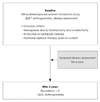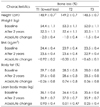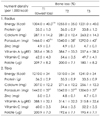Abstract
This study was conducted to investigate dietary factors, bone status, and bone loss in postmenopausal women in rural areas. A total of 189 women participated in the follow-up study after two years. Radius, Tibia, and Phalanx SOS (Speed of Sound) was measured on two occasions 2 years apart by ultra-sonic-metry, and % body fat was measured by bioelectrical impedance analysis at the baseline and after 2years. Dietary intake data were collected 4 times at different season by 24-hour recall method, and then calculated as average. Bone density of radius decreased by 4.2% during the two year period. When the subjects were divided into three groups, by bone decline level during two years, the lowest bone loss group had higher potassium and vegetable intake than other groups. Age and calcium intakes showed significant correlation with bone decline rate at tibia. In multiple regressions, the baseline SOS, vitamin A, vegetables and eggs intakes were found to be significant factors for tibia bone decline. In conclusion, dietary factors, such as higher vegetable intake, seem to affect the changes in bone mineral density in more favorable way. Therefore, efforts are needed to enhance the access to nutritional care for rural elderly postmenopausal women.
Figures and Tables
Table 4
Age, menopausal age, duration after menopause and number of birth by tertile of bone loss at radius

Table 10
Multiple regression analysis with baseline bone SOS, and nutrient density and food intake as independent variables and bone loss (%) at radius

1)*: p < 0.05, **: p < 0.01, ***: p < 0.001 2) The entered variables were age, height, baseline body fat (kg), change in body fat (kg), baseline lean body mass, change in lean body mass, total energy, nutrients expressed as the nutrient density (protein, fat, cholesterol, carbohydrate, Ca, P, Fe, K, Na, Zn, niacin, folate, dietary fiber, vitamin A, vitamin B1, vitamin B2, vitamin C), food intakes and baseline bone SOS at radius
References
1. Statistics Korea. Report of society investigation. 2011. Daejeon: Statistics Korea.
2. Kim OS, Ryu HS. The study on blood lipid levels according to the food habits and food intake patterns in Korean elderly. Korean J Food Nutr. 2009. 22(3):421–429.
3. Uh SB, Kim HS, Baek K, Kang KH, Yuk JY, Kim BS. A study on risk factors of nutrition in a rural aged people. J Korea Sport Res. 2005. 16(6):237–250.
4. Ministry of Health and Welfare, Korea Centers for Disease Control and Prevention. Korean National Health and Nutrition Examination Survey. 2010. Cheongwon: Korea Centers for Disease Control and Prevention.
5. Jang S, Park C, Jang S, Yoon HK, Shin CS, Kim DY, Ha YC, Lee SS, Choi HJ, Lee YK, Kim BT, Choi JY. Medical service utilization with osteoporosis. Endocrinol Metab. 2010. 25(4):326–339.

6. Ministry of Health and Welfare, Korea Centers for Disease Control and Prevention. Korean National Health and Nutrition Examination Survey. 2008. Cheongwon: Korea Centers for Disease Control and Prevention.
7. Lee WJ, Kim NW. A statistical compare analysis of bone mineral density of lumbar spine and femur, risk factors for osteoporosis in the women of pre, postmenopausal. J Radiol Sci Technol. 2005. 28(3):227–234.
8. Aaseth J, Boivin G, Andersen O. Osteoporosis and trace elements--an overview. J Trace Elem Med Biol. 2012. 26(2-3):149–152.
9. Moon ES, Lee ES. The relationship between knowledge, health beliefs, and prevention behaviors of osteoporotic fracture in patients receiving osteoporosis treatment. Korean J Women Health Nurs. 2010. 16(2):147–156.

10. Lee JS, Yu CH. Some factors affecting bone mineral density of Korean rural women. Korean J Nutr. 1999. 32(8):935–945.
11. Lim S, Shin CS, Kim KS, Kim SY, Bang EJ, Shin EK, Choi HR, Chung MH, Cho SI. Determinants of limb-bone mineral density in healthy men and women aged over 50 in rural area. J Korean Soc Endocrinol. 2003. 18(2):193–205.
12. Sung CJ, Choi YH, Kim MH, Choi SH, Cho KO. A study of nutrient intake and serum levels of osteocalcin, Ca, P, and Mg and their correlation to bone mineral density in Korean postmenopausal women residing in rural areas. Korean J Community Nutr. 2002. 7(1):111–120.
14. Shin YL. Assessment of bone mineral density. J Korean Soc Pediatr Endocrinol. 2006. 11(2):123–130.
15. Chung SJ, Kang SH, Song SM, Ryu SH, Yoon J. Nutritional quality of Korean adults' consumption of lunch prepared at home, commercial places, and institutions: analysis of the data from the 2001 National Health and Nutrition Survey. Korean J Nutr. 2006. 39(8):841–849.
16. Baek KH, Kang MI. Official positions of the international society for clinical densitometry. J Korean Soc Endocrinol. 2005. 20(1):1–7.

17. Park J, Choi M, Lee S, Choi Y, Park Y. The association between bone mineral density, bone turnover markers, and nutrient intake in pre- and postmenopausal women. Korean J Nutr. 2011. 44(1):29–40.

18. Ahlborg HG, Johnell O, Nilsson BE, Jeppsson S, Rannevik G, Karlsson MK. Bone loss in relation to menopause: a prospective study during 16 years. Bone. 2001. 28(3):327–331.

19. Baczyk G, Chuchracki M, Klejewski A. The relationship between selected biochemical parameters, clinical factors and bone mineral density in postmenopausal women with osteoporosis. Ginekol Pol. 2012. 83(3):194–201.
20. Lee MK, Yoon BK, Chung HY, Park HM. The serum vitamin D nutritional status and its relationship with skeletal status in Korean postmenopausal women. Korean J Obstet Gynecol. 2011. 54(5):241–246.

21. Saarelainen J, Kiviniemi V, Kröger H, Tuppurainen M, Niskanen L, Jurvelin J, Honkanen R. Body mass index and bone loss among postmenopausal women: the 10-year follow-up of the OSTPRE cohort. J Bone Miner Metab. 2012. 30(2):208–216.

22. Greendale GA, Sowers M, Han W, Huang MH, Finkelstein JS, Crandall CJ, Lee JS, Karlamangla AS. Bone mineral density loss in relation to the final menstrual period in a multi-ethic cohort: Results from the study of women's health across the nation (SWAN). J Bone Miner Res. 2012. 27(1):111–118.

23. Chung JE, Hwang SJ, Kim MJ, Song JY, Cho HH, Kwon DJ, Lew YO, Lim YT, Kim EJ, Kim JH, Kim JH, Kim MR. Relationship between body composition and bone mineral density in pre- and post-menopausal women. J Korean Soc Menopause. 2010. 16(1):29–38.
24. Cure-Cure C, Cure-Ramírez P, Terán E, López-Jaramillo P. Bone-mass peak in multiparity and reduced risk of bone-fractures in menopause. Int J Gynaecol Obstet. 2002. 76(3):285–291.

25. Hur SE, Chung HW. Age related difference in the bone mineral density of the distal forearm in Korean women. J Korean Soc Menopause. 2003. 9(3):226–231.
26. Jeong IG, Yoon JH, Kim JO, Kim YP, Lee MS, Yoon JS, Byun JJ. Relationship of isokinetic flexion and extension muscle strength, muscle mass to bone mineral density in body limbs. Korean J Sports Med. 2003. 21(2):176–183.
27. Bae YJ, Sung CJ. A comparison between postmenopausal osteoporotic women and normal women of their nutrient intakes and the evaluation of diet quality. Korean J Community Nutr. 2005. 10(2):205–215.
28. Farrell VA, Harris M, Lohman TG, Going SB, Thomson CA, Weber JL, Houtkooper LB. Comparison between dietary assessment methods for determining associations between nutrient intakes and bone mineral density in postmenopausal women. J Am Diet Assoc. 2009. 109(5):899–904.

29. Yeon JY, Sung CJ. A study on dietary mineral intakes, urinary mineral excretions, and bone mineral density in Korean postmenopausal women. Korean J Community Nutr. 2011. 16(5):569–579.

30. Kim KR, Kim KH, Lee EK, Lee SS. A study on the factors affecting bone mineral density in adult women-based on the mothers of elementary school students. Korean J Nutr. 2000. 33(3):241–249.
31. Park HM, Heo J, Park Y. Calcium from plant sources is beneficial to lowering the risk of osteoporosis in postmenopausal Korean women. Nutr Res. 2011. 31(1):27–32.

32. Kim MS, Koo JO. Analysis of factors affecting bone mineral density with different age among adult women in Seoul area. Korean J Community Nutr. 2007. 12(5):559–568.
33. Tucker KL, Chen H, Hannan MT, Cupples LA, Wilson PW, Felson D, Kiel DP. Bone mineral density and dietary patterns in older adults: the Framingham Osteoporosis Study. Am J Clin Nutr. 2002. 76(1):245–252.

34. Promislow JH, Goodman-Gruen D, Slymen DJ, Barrett-Connor E. Retinol intake and bone mineral density in the elderly: the Rancho Bernardo Study. J Bone Miner Res. 2002. 17(8):1349–1358.

35. Ribaya-Mercado JD, Blumberg JB. Vitamin A: is it a risk factor for osteoporosis and bone fracture? Nutr Rev. 2007. 65(10):425–438.





 PDF
PDF ePub
ePub Citation
Citation Print
Print












 XML Download
XML Download